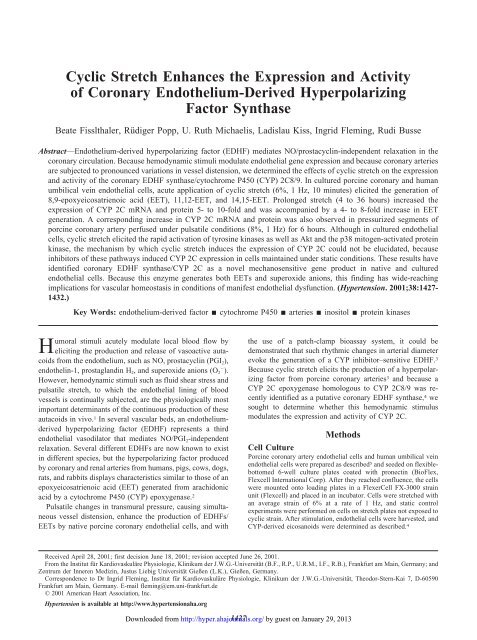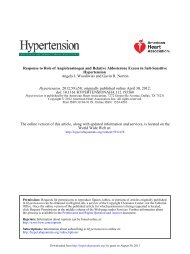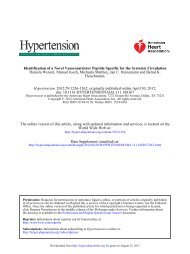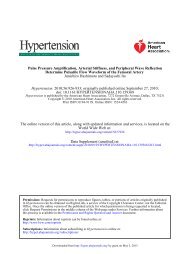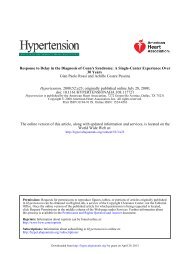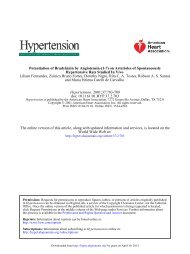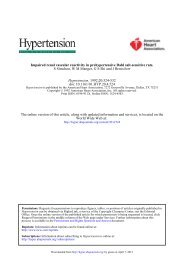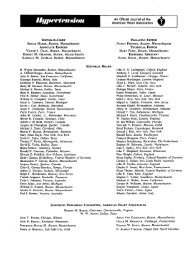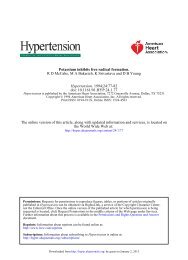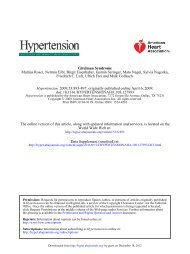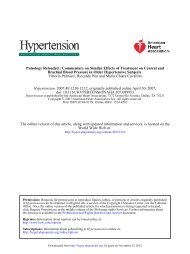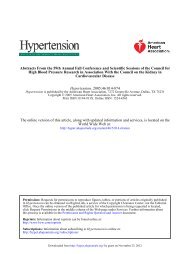Busse Beate Fisslthaler, Rüdiger Popp, U. Ruth ... - Hypertension
Busse Beate Fisslthaler, Rüdiger Popp, U. Ruth ... - Hypertension
Busse Beate Fisslthaler, Rüdiger Popp, U. Ruth ... - Hypertension
You also want an ePaper? Increase the reach of your titles
YUMPU automatically turns print PDFs into web optimized ePapers that Google loves.
Cyclic Stretch Enhances the Expression and Activity<br />
of Coronary Endothelium-Derived Hyperpolarizing<br />
Factor Synthase<br />
<strong>Beate</strong> <strong>Fisslthaler</strong>, <strong>Rüdiger</strong> <strong>Popp</strong>, U. <strong>Ruth</strong> Michaelis, Ladislau Kiss, Ingrid Fleming, Rudi <strong>Busse</strong><br />
Abstract—Endothelium-derived hyperpolarizing factor (EDHF) mediates NO/prostacyclin-independent relaxation in the<br />
coronary circulation. Because hemodynamic stimuli modulate endothelial gene expression and because coronary arteries<br />
are subjected to pronounced variations in vessel distension, we determined the effects of cyclic stretch on the expression<br />
and activity of the coronary EDHF synthase/cytochrome P450 (CYP) 2C8/9. In cultured porcine coronary and human<br />
umbilical vein endothelial cells, acute application of cyclic stretch (6%, 1 Hz, 10 minutes) elicited the generation of<br />
8,9-epoxyeicosatrienoic acid (EET), 11,12-EET, and 14,15-EET. Prolonged stretch (4 to 36 hours) increased the<br />
expression of CYP 2C mRNA and protein 5- to 10-fold and was accompanied by a 4- to 8-fold increase in EET<br />
generation. A corresponding increase in CYP 2C mRNA and protein was also observed in pressurized segments of<br />
porcine coronary artery perfused under pulsatile conditions (8%, 1 Hz) for 6 hours. Although in cultured endothelial<br />
cells, cyclic stretch elicited the rapid activation of tyrosine kinases as well as Akt and the p38 mitogen-activated protein<br />
kinase, the mechanism by which cyclic stretch induces the expression of CYP 2C could not be elucidated, because<br />
inhibitors of these pathways induced CYP 2C expression in cells maintained under static conditions. These results have<br />
identified coronary EDHF synthase/CYP 2C as a novel mechanosensitive gene product in native and cultured<br />
endothelial cells. Because this enzyme generates both EETs and superoxide anions, this finding has wide-reaching<br />
implications for vascular homeostasis in conditions of manifest endothelial dysfunction. (<strong>Hypertension</strong>. 2001;38:1427-<br />
1432.)<br />
Key Words: endothelium-derived factor � cytochrome P450 � arteries � inositol � protein kinases<br />
Humoral stimuli acutely modulate local blood flow by<br />
eliciting the production and release of vasoactive autacoids<br />
from the endothelium, such as NO, prostacyclin (PGI2), � endothelin-1, prostaglandin H2, and superoxide anions (O2 ).<br />
However, hemodynamic stimuli such as fluid shear stress and<br />
pulsatile stretch, to which the endothelial lining of blood<br />
vessels is continually subjected, are the physiologically most<br />
important determinants of the continuous production of these<br />
autacoids in vivo. 1 In several vascular beds, an endotheliumderived<br />
hyperpolarizing factor (EDHF) represents a third<br />
endothelial vasodilator that mediates NO/PGI2-independent relaxation. Several different EDHFs are now known to exist<br />
in different species, but the hyperpolarizing factor produced<br />
by coronary and renal arteries from humans, pigs, cows, dogs,<br />
rats, and rabbits displays characteristics similar to those of an<br />
epoxyeicosatrienoic acid (EET) generated from arachidonic<br />
acid by a cytochrome P450 (CYP) epoxygenase. 2<br />
Pulsatile changes in transmural pressure, causing simultaneous<br />
vessel distension, enhance the production of EDHFs/<br />
EETs by native porcine coronary endothelial cells, and with<br />
the use of a patch-clamp bioassay system, it could be<br />
demonstrated that such rhythmic changes in arterial diameter<br />
evoke the generation of a CYP inhibitor–sensitive EDHF. 3<br />
Because cyclic stretch elicits the production of a hyperpolarizing<br />
factor from porcine coronary arteries 3 and because a<br />
CYP 2C epoxygenase homologous to CYP 2C8/9 was recently<br />
identified as a putative coronary EDHF synthase, 4 we<br />
sought to determine whether this hemodynamic stimulus<br />
modulates the expression and activity of CYP 2C.<br />
Methods<br />
Cell Culture<br />
Porcine coronary artery endothelial cells and human umbilical vein<br />
endothelial cells were prepared as described 5 and seeded on flexiblebottomed<br />
6-well culture plates coated with pronectin (BioFlex,<br />
Flexcell International Corp). After they reached confluence, the cells<br />
were mounted onto loading plates in a FlexerCell FX-3000 strain<br />
unit (Flexcell) and placed in an incubator. Cells were stretched with<br />
an average strain of 6% at a rate of 1 Hz, and static control<br />
experiments were performed on cells on stretch plates not exposed to<br />
cyclic strain. After stimulation, endothelial cells were harvested, and<br />
CYP-derived eicosanoids were determined as described. 4<br />
Received April 28, 2001; first decision June 18, 2001; revision accepted June 26, 2001.<br />
From the Institut für Kardiovaskuläre Physiologie, Klinikum der J.W.G.-Universität (B.F., R.P., U.R.M., I.F., R.B.), Frankfurt am Main, Germany; and<br />
Zentrum der Inneren Medizin, Justus Liebig Universität Gießen (L.K.), Gießen, Germany.<br />
Correspondence to Dr Ingrid Fleming, Institut für Kardiovaskuläre Physiologie, Klinikum der J.W.G.-Universität, Theodor-Stern-Kai 7, D-60590<br />
Frankfurt am Main, Germany. E-mail fleming@em.uni-frankfurt.de<br />
© 2001 American Heart Association, Inc.<br />
<strong>Hypertension</strong> is available at http://www.hypertensionaha.org<br />
Downloaded from<br />
http://hyper.ahajournals.org/ 1427 by guest on January 29, 2013


